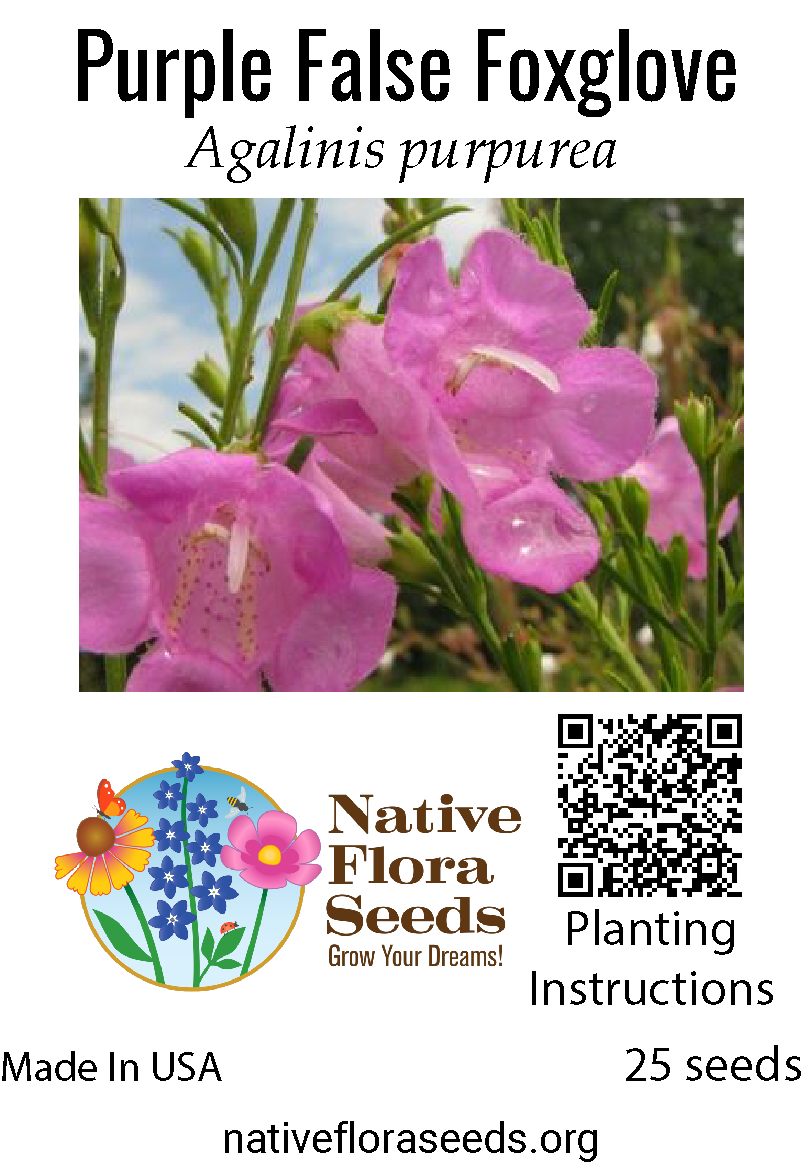Here's a guide to planting Agalinis purpurea (Purple Agalinis), covering direct sowing outdoors in fall and spring, and starting seeds indoors for later transplanting:
Site Selection
Sunlight: Purple Agalinis thrives in full sun, requiring at least 6 hours of direct sunlight daily. It can tolerate some light shade, but flowering will be diminished.
Soil: Well-drained soil is essential. Sandy or loamy soils are ideal. Avoid heavy clay soils that retain too much moisture. This plant prefers slightly acidic to neutral soil pH.
Location: Choose a location that mimics its native habitat: open fields, meadows, or coastal areas. It can tolerate some drought once established.
Soil Preparation
Clean the area: Remove all weeds, rocks, and debris from the planting site. Purple Agalinis doesn't compete well with other plants, especially during establishment.
Loosen the soil: If the soil is compacted, loosen it with a garden fork or tiller to a depth of about 6 inches. This improves drainage and allows roots to penetrate easily.
Amend the soil (optional): While not strictly necessary, incorporating a small amount of compost or well-rotted manure can improve soil fertility and drainage, particularly in poor soils. Avoid excessive fertilization, as this can encourage excessive foliage growth at the expense of flowering.
Planting
Sowing outdoors in fall:
Sow seeds in late fall, just before the first expected frost. This allows the seeds to naturally stratify over winter.
Prepare a clean, weed-free seedbed.
Sow seeds very lightly on the surface of the soil. Do not cover the seeds, or cover them very lightly with a thin layer of sand or fine soil (no more than 1/16 inch). They need light to germinate.
Water gently but thoroughly after sowing.
Sowing outdoors in spring:
Sow seeds in early spring, after the last expected frost.
Prepare the seedbed as described above.
Sow seeds as described above for fall planting.
Keep the soil consistently moist until germination.
Starting seeds indoors (for later transplanting):
Start seeds 6-8 weeks before the last expected frost in your area.
Use seed starting mix in small pots or trays.
Sow seeds on the surface of the soil and very lightly cover with sand or vermiculite.
Keep the soil moist and provide bright light. Germination can be erratic.
Harden off seedlings gradually before transplanting outdoors in spring after the last frost. Space plants about 6-12 inches apart.
Stratification
Need: Stratification is highly recommended for Purple Agalinis seeds to improve germination rates. Cold, moist stratification mimics natural winter conditions.
Method:
Mix seeds with slightly moistened sand or vermiculite in a sealed container or plastic bag.
Store the container in the refrigerator for 4-6 weeks.
Sow seeds after stratification, whether indoors or directly outdoors.
Scarification
Need: Scarification is not typically required for Purple Agalinis seeds.
Watering
Keep the soil consistently moist during germination and establishment.
Once established, Purple Agalinis is relatively drought-tolerant. Water deeply but infrequently, allowing the soil to dry slightly between waterings. Avoid overwatering, which can lead to root rot.
Maintenance
Purple Agalinis requires minimal maintenance.
Weed regularly, especially during the first year, to reduce competition.
Deadheading is not necessary, as the plant self-seeds.
In its natural habitat, it's a short-lived perennial, often behaving like an annual.
Invasiveness
Purple Agalinis is not considered invasive. It's a native plant that plays a valuable role in its ecosystem.
Important Considerations:
Purple Agalinis is hemiparasitic, meaning it obtains some nutrients from other plants through its roots. While it's not considered harmful to most plants, avoid planting it directly next to very small or delicate species.
This plant is a specialist in its habitat and can be challenging to grow outside of ideal conditions.
By following these guidelines, you'll increase your chances of successfully growing Purple Agalinis in your garden. Remember to adapt these instructions to your specific location and growing conditions.



